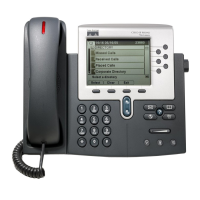Chapter 2 Getting Started with Your Cisco SIP IP Phone
Installing the Cisco SIP IP Phone
2-6
Cisco SIP IP Phone 7960 Administrator Guide
78-10497-02
Configuring SIP Parameters via a TFTP Server
If you are configuring SIP parameters via a TFTP server, you must use
configuration files.
There are two configuration files that you can use to define the SIP parameters;
the default configuration file (optional) and the phone-specific configuration file
(required). If you choose to use a default configuration file, you must store the file
in the root directory of your TFTP server. Phone-specific configuration files can
be stored in the root directory or in a subdirectory in which all phone-specific
configuration files are stored.
Except for parameters used to defined the lines and users on a phone, all other SIP
parameters can be defined in either the default configuration file or the
phone-specific configuration file. However, for network control and maintenance
purposes, we recommend that you define the parameters that you want to apply to
all phones in the default configuration file (SIPDefault.cnf). Phone-specific
parameters should only be defined via a phone-specific configuration file or
manually configured. Phone-specific parameters should not be defined in the
default configuration file.
Configuration File Guidelines
When modifying the default configuration file and creating the phone-specific
configuration files, adhere to the following guidelines and requirements:
•
SIP parameters specified in the default configuration file (SIPDefault.cnf)
will override those parameters stored in Flash memory. Parameters specified
in a phone-specific configuration file will override those stored in Flash
memory and parameters specified in the default configuration file.
•
The name of each phones’ phone-specific configuration file is unique and is
based on the MAC address of the phone.
The format of the file name must be “SIPXXXXYYYYZZZZ.cnf” where
XXXXYYYYZZZZ is the MAC address of the phone. The MAC address must
be in uppercase and the extension, cnf, must be in lower case (for example,
SIP00503EFFD842.cnf).
Note
The MAC address of a phone is identified on the middle
sticker adhered to the base of the phone and can also be
viewed on the Network Configuration menu.

